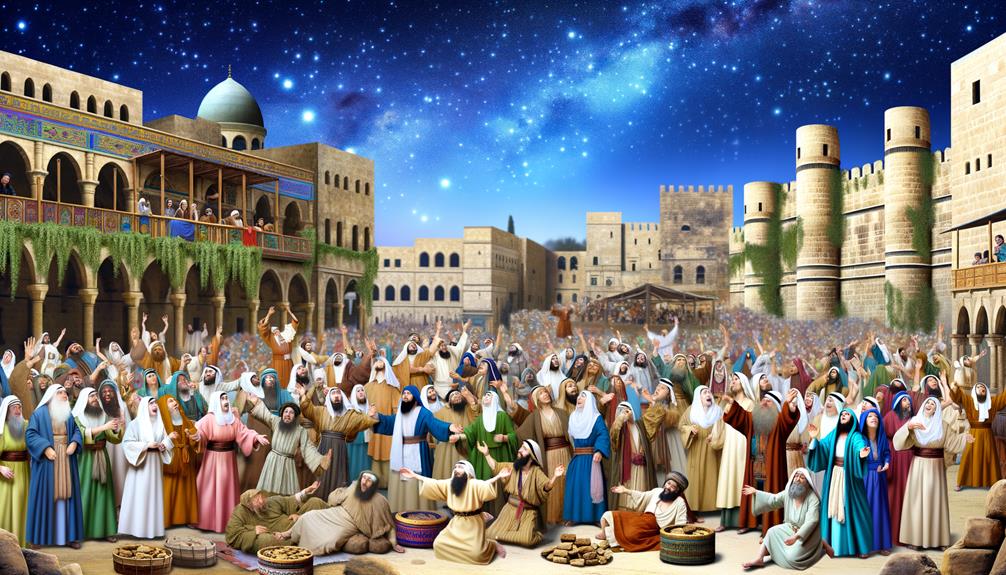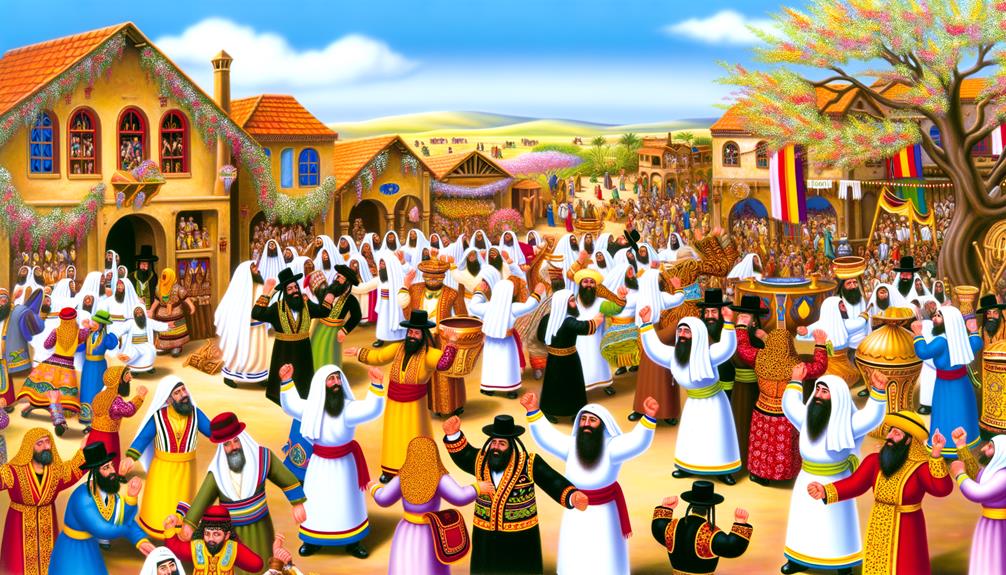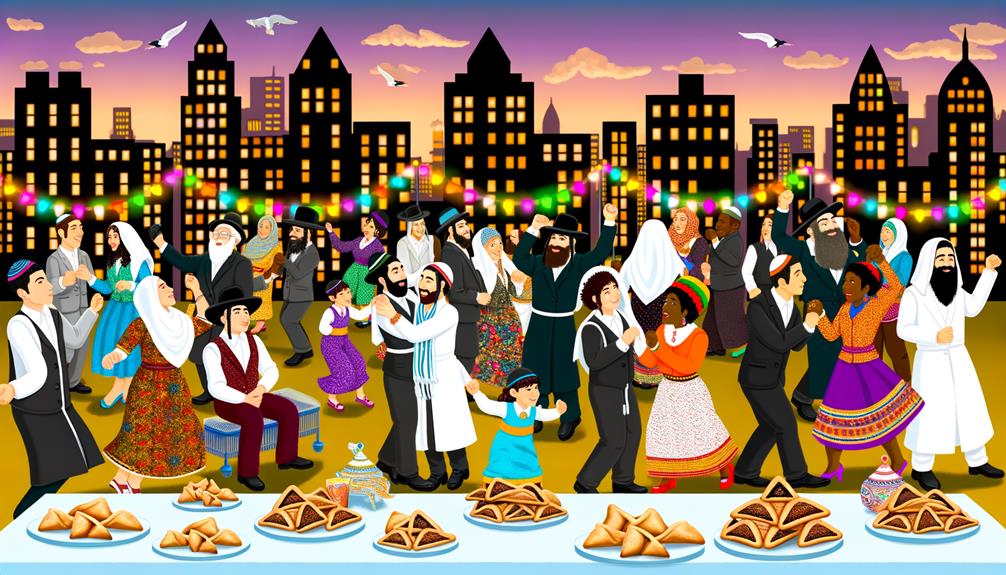Adar Meaning In The Bible: Month of Joy
Adar, the twelfth month of the Jewish calendar, is steeped in historical and spiritual significance in the Bible. Originating from ancient Mesopotamian traditions, Adar is particularly marked by the joy and resilience depicted in the festival of Purim, which commemorates the survival of the Jewish people against Haman’s plot as narrated in the Book of Esther.
The month, derived from the Akkadian word ‘Adaru,’ meaning ‘glorious’ or ‘exalted,’ symbolizes strength and divine intervention. Key events such as the completion of the Second Temple in 516 BCE further its significance, offering rich narratives and cultural practices for deeper exploration.

Adar Meaning in the Bible: Significance of the Twelfth Hebrew Month
| Aspect | Explanation |
|---|---|
| Biblical Context | Twelfth month in the Hebrew calendar (Esther 3:7) |
| Spiritual Symbolism | Joy, celebration, and divine deliverance |
| Key Biblical Event | Festival of Purim, marking Jewish salvation in the Book of Esther |
| Name Meaning | “Strength” or “Glorious” in Hebrew |
| Faith Message | A reminder of God’s providence and victory over adversity |
Origins of Adar

The origins of Adar trace back to ancient Mesopotamian civilizations, where it was initially recognized as the twelfth month of the Babylonian calendar.
This historical context is pivotal, as the Babylonian calendar was lunisolar, balancing both lunar cycles and solar years. Adar, often associated with the end of the agricultural year, signified a period of preparation and reflection before the new cycle commenced.
The Babylonian influence on regional calendars was profound, permeating various cultures, including the Hebrews. Understanding Adar’s Babylonian roots provides an extensive backdrop for its subsequent adaptations and integrations.
This period also marked significant religious and societal events, underscoring its importance beyond mere chronology, thereby highlighting its enduring legacy in calendrical systems.
Adar in the Jewish Calendar

Building upon its Babylonian origins, Adar’s integration into the Jewish calendar marks it as the twelfth and final month, holding significant religious and cultural importance. Adar often corresponds to February-March in the Gregorian calendar and includes 29 days, or 30 in a leap year when Adar II is added.
Historically, the Jewish leap year reconciles lunar and solar cycles, ensuring festivals align seasonally. The month is also notable for joyous observances and communal reflections.
| Aspect | Detail |
|---|---|
| Position | Twelfth month |
| Gregorian Equivalent | February-March |
| Days in Month | 29 (30 in leap years) |
| Leap Year Adjustment | Addition of Adar II |
| Cultural Practices | Joyous observances, reflections |
Understanding Adar’s place in the Jewish calendar provides insight into its cyclical and celebratory nature.
Significance of Purim

Emerging from the narrative of the Book of Esther, Purim commemorates the salvation of the Jewish people from a plot of annihilation in ancient Persia. This event, orchestrated by Haman, a royal advisor, underscores themes of resilience and divine providence.
Historically, Purim is celebrated on the 14th of Adar, following the defeat of Haman’s decree. This festival includes the public recitation of the Megillah (Book of Esther), giving charity, exchanging food gifts, and festive meals.
The historical context of Purim reveals a community’s survival against existential threats, reflecting broader themes of Jewish perseverance. Through rituals and remembrances, Purim fortifies communal identity and continuity, illustrating the enduring relevance of historical narratives in Jewish cultural and religious life.
Adar’s Name and Meaning

Often overlooked in casual discussions, the name ‘Adar’ holds profound significance in biblical texts, embodying themes of strength and joy as the twelfth month of the Hebrew calendar.
Derived from the Akkadian word ‘Adaru,’ Adar signifies ‘glorious’ or ‘exalted,’ reflecting a time of celebration and resilience.
Historically, Adar aligns with the late winter months, typically February-March in the Gregorian calendar. It is a period marked by the festival of Purim, commemorating Jewish deliverance as recounted in the Book of Esther.
Key points about Adar:
- Etymology: Derived from Akkadian, meaning ‘glorious.’
- Calendar Position: Twelfth month of the Hebrew calendar.
- Seasonal Alignment: Corresponds to February-March.
- Cultural Importance: Features the festival of Purim.
These elements collectively enrich the understanding of Adar’s name and meaning.
Biblical References to Adar

Numerous biblical references to Adar underscore its significance, particularly in the context of Jewish history and religious observances.
The month of Adar, the twelfth month of the Jewish calendar, is especially mentioned in the Book of Esther, where the festival of Purim is instituted to commemorate the salvation of the Jewish people from Haman’s plot.
Ezra 6:15 also highlights Adar, marking the completion of the Second Temple’s construction during this month. The historical context of these events establishes Adar as a time pivotal for Jewish identity and continuity.
Adar as a Time of Joy

Adar is historically regarded as a period of joy within the Jewish calendar, primarily due to its association with the festival of Purim, which commemorates the deliverance of the Jewish people from Haman’s plot as recounted in the Book of Esther.
This month is imbued with celebratory customs and cultural traditions that underscore themes of survival, communal unity, and divine providence.
Celebrating Jewish Festivals
The month of Adar, marked by the celebration of Purim, epitomizes a period of unparalleled joy and festivity in the Jewish calendar, deeply rooted in historical traditions and religious observances.
Purim, commemorating the Jewish people’s deliverance from Haman’s plot as recorded in the Book of Esther, is central to Adar’s celebrations. The customs associated with this festival underscore the communal and joyous nature of the month.
- Megillah Reading: Public readings of the Book of Esther recount the miraculous events.
- Mishloach Manot: Exchanging gifts of food and drink fosters community spirit.
- Matanot La’Evyonim: Giving to the poor guarantees inclusivity.
- Festive Meals: Lavish feasts reflect the celebration of survival and triumph.
These practices illustrate Adar’s unique role in Jewish life.
Historical Significance of Adar
In examining the historical significance of Adar, its designation as a time of joy is deeply rooted in the collective memory of Jewish survival and resilience, particularly exemplified by the events recorded in the Book of Esther.
This biblical narrative recounts the deliverance of the Jewish people from a genocidal plot orchestrated by Haman, a high-ranking official in the Persian Empire.
The miraculous reversal of fortune, where the Jews triumphed over their enemies, led to the establishment of the festival of Purim, celebrated during Adar.
This month, consequently, symbolizes not only the historical victory over oppression but also serves as an enduring affirmation to the steadfastness and faith of the Jewish people through adversity.
Traditions and Customs
As the month of Adar approaches, Jewish communities worldwide engage in a series of traditions and customs that emphasize joy and communal celebration, deeply rooted in centuries-old practices and historical context. This period is marked by an uptick in festivity, reflecting the triumphs and joys associated with the Jewish calendar.
- Purim: Celebrated on the 14th of Adar, this festival commemorates the deliverance of the Jewish people from Haman’s plot, as recounted in the Book of Esther.
- Mishloach Manot: The custom of sending food parcels to friends and family, fostering unity and joy.
- Reading the Megillah: Public recitations of the Book of Esther, highlighting the narrative of Jewish survival and resilience.
- Purim Spiel: Theatrical performances and parodies that retell the Purim story, enhancing communal joy and laughter.
Historical Events in Adar

The month of Adar holds significant historical weight in biblical context, marked by pivotal events such as the origins of the Purim celebration, which commemorates the Jewish people’s deliverance from Haman’s plot as recorded in the Book of Esther.
Additionally, Adar is noted for the completion of the Second Temple, a monumental achievement in Jewish history.
The month also memorializes the death anniversaries of several kings, providing a period of both reflection and reverence.
Purim Celebration Origins
Originating from the Book of Esther, the celebration of Purim commemorates the deliverance of the Jewish people from a plot to annihilate them in the ancient Persian Empire during the month of Adar. This festival, rich in historical significance, marks key events that are foundational to Jewish identity and resilience.
The narrative, set during the reign of King Ahasuerus, highlights pivotal moments:
- Mordecai’s Refusal: Mordecai’s defiance against bowing to Haman, the king’s advisor.
- Haman’s Plot: Haman’s scheme to exterminate the Jews, casting lots (purim) to determine the massacre date.
- Esther’s Intervention: Queen Esther’s courageous plea to the king, revealing her Jewish identity.
- Jewish Victory: The reversal of fortune, where the Jewish people triumphed over their enemies.
Second Temple Completion
Notably, the month of Adar holds considerable historical importance as it marks the completion of the Second Temple in Jerusalem, a pivotal event in Jewish history.
Completed in 516 BCE, this monumental achievement symbolized the restoration of Jewish religious life and national identity after the Babylonian Exile.
The Second Temple became the center of Jewish worship and practice, embodying the fulfillment of prophetic promises. This period saw the revival of sacrificial rites and the re-establishment of the priesthood, solidifying religious traditions that persisted for centuries.
The completion in Adar is not merely a historical milestone but a profound reflection of resilience and faith, shaping Jewish collective memory and theological perspectives profoundly.
Kings’ Death Anniversaries
Among the various historical events commemorated in the month of Adar, the death anniversaries of significant kings stand out for their profound impact on Jewish history and collective memory.
These events offer a window into the past, shedding light on the intricate relationship between leadership and the Jewish people’s spiritual and political journey.
Significantly, the month of Adar is marked by the remembrance of the following kings:
- King Josiah: Known for his religious reforms, his death marked a significant turning point.
- King Saul: His tragic demise in battle is a pivotal moment in Jewish history.
- King Ahasuerus (Xerxes I): His reign is central to the story of Purim.
- King Jehoiachin: His release from Babylonian captivity is a symbol of hope and resilience.
These anniversaries are integral to understanding the historical and cultural context of Adar.
Spiritual Symbolism of Adar

The month of Adar, within the Hebrew calendar, holds profound spiritual symbolism, often representing joy, redemption, and divine intervention as exemplified in the celebration of Purim.
Historically, Adar is associated with the Jewish people’s survival against annihilation, as narrated in the Book of Esther. The festive nature of Purim, marked by feasting and merrymaking, underscores the triumph of light over darkness, and the reversal of seemingly insurmountable decrees.
Additionally, Adar’s position as the twelfth month signifies completion and a preparatory phase for renewal in the upcoming month of Nisan. This cyclical shift embodies not only physical but also spiritual rejuvenation, inviting reflections on providence, communal resilience, and the perpetual presence of divine benevolence in times of adversity.
Adar and Divine Intervention

The month of Adar holds significant historical instances where divine intervention is prominently showcased, most importantly in the story of Purim, which commemorates the miraculous salvation of the Jews from Haman’s decree.
This period highlights God’s hand in altering the course of events, underscoring themes of providence and deliverance.
Analyzing these occurrences allows for a deeper understanding of how divine intervention is perceived and represented in the biblical narrative.
Miracles in Adar
Adar’s historical significance in the Bible is often highlighted by the miraculous events that underscore divine intervention during this pivotal month. These events serve as profound reminders of God’s ability to alter the course of history and deliver His people in times of distress.
- Purim: The Jewish festival of Purim, celebrated in Adar, commemorates the deliverance of the Jews from Haman’s plot, as recounted in the Book of Esther.
- Temple Rededication: Historical records suggest that significant repairs and rededications of the Jerusalem Temple occurred during Adar.
- Completion of Walls: Nehemiah’s completion of Jerusalem’s walls is another miraculous event linked to Adar.
- Spiritual Significance: The month also emphasizes themes of joy and transformation, reflecting the divine miracles that transpired.
God’s Hand Revealed
Examining the narratives of divine intervention during Adar reveals the profound ways in which God’s hand has shaped and safeguarded the destiny of His people throughout biblical history.
The Jewish festival of Purim, celebrated in Adar, commemorates the miraculous salvation of the Jewish people from Haman’s genocidal plot, as recounted in the Book of Esther. This event exemplifies divine orchestration, where seemingly coincidental events align to manifest God’s protection.
The appointment of Esther as queen and Mordecai’s timely discovery of a conspiracy against King Ahasuerus underscore this divine intervention. Such instances during Adar highlight the enduring belief in God’s providence and His active role in guiding and preserving His chosen people amidst adversity.
Adar in Jewish Tradition

Within Jewish tradition, the month of Adar holds significant historical and cultural importance, often associated with themes of joy and deliverance. Adar is the twelfth month of the Hebrew calendar, and its prominence is underscored by several key historical events and religious practices.
The most notable is the festival of Purim, which commemorates the Jews’ salvation from Haman’s plot as recounted in the Book of Esther. Adar is also a time for communal and personal reflection, celebrating Jewish resilience and divine providence.
Key aspects of Adar in Jewish tradition include:
- Purim: Celebrating the deliverance of Jews in Persia.
- Increased Joy: Adar is a month of happiness.
- Leap Year: Adar is doubled in Jewish leap years.
- Historical Events: Significant events such as Moses’ birth and death.
Modern Observances of Adar

In contemporary times, the observance of Adar continues to be a vibrant and integral part of Jewish life, marked by various cultural and religious activities that honor its historical significance and themes of joy.
Central to the month is the celebration of Purim, commemorating the deliverance of the Jewish people from Haman’s plot as recounted in the Book of Esther.
Modern observances include reading the Megillah, festive meals, charity (matanot la’evyonim), and mishloach manot (gifts of food).
Additionally, Adar is imbued with a spirit of joy, reflected in increased communal activities, music, and dance.
These practices underscore the resilience and enduring cultural heritage of the Jewish people, linking past triumphs to present celebrations.
Conclusion
Adar, the twelfth month of the Jewish calendar, holds profound religious and historical significance, particularly due to the celebration of Purim, which commemorates Jewish deliverance as recounted in the Book of Esther.
An intriguing statistic reveals that Adar is the only month occasionally duplicated in Jewish leap years, leading to Adar I and Adar II, thereby ensuring the lunar calendar‘s alignment with the solar year.
This unique aspect underscores Adar’s pivotal role in maintaining the cyclical integrity of Jewish timekeeping.






